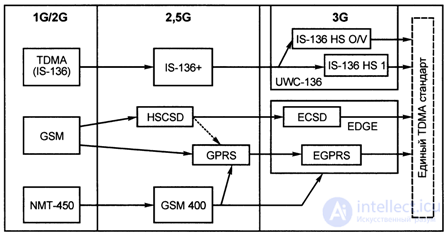Lecture
Currently, the basic capabilities of the GSM standard have not yet been fully implemented, and the developers have laid the foundations for the further development and modernization of the GSM standard.
The improvement of GSM networks goes in the direction of UMTS / IMT-2000 in the following interrelated areas:
- integration with other radio networks: DECT, DCS1800, PSC1900, as well as with Internet / intranet access networks;
- creation of integrated networks GSM 900 / GSM 1800 and in the future GSM 400;
- introduction of new digital technologies, including:
■ generalized packet radio services - GPRS (General Packet Radio Service), which provide for the construction of packet-switched networks such as X.25, IP and ATM, as well as interworking with fixed PSTN and ISDN networks;
■ High-speed circuit switched data transmission - HSCSD (High Speed Circuit Switched Data);
■ improved data transfer for the global evolution of communication systems - EDGE (Enhanced Data rates for GSM Evolution), designed to transition GSM systems to the third generation 3G;
- introduction of the GSM 400 system for mobile communications in rural and sparsely populated areas;
- development of various service functions (billing, connection of fax terminals, modems, communication security procedures, etc.);
- inclusion in the GSM architecture of new protocols and application services that meet the requirements of the 3rd generation systems.
It is obvious that the modernization of GSM and the development of UMTS will occur for a long time. At the same time, both technologies will be developed in parallel.
The first phase is the beginning stage of the implementation of circuit-switched data transfer HSCSD technology.
The next phase is the implementation of new versions of the GSM standard, namely GPRS and EDGE, which are a platform that is convenient for implementing UMTS services. This phase is usually denoted as either “2G +” or “2.5G” (Fig. 10.2).

Fig. 10.2. ETSI specifications for the phased evolution of GSM standards to the 3rd generation.
In fig. 10.2 shows the list of specifications developed by ETSI for the purpose of a phased evolution of GSM standards to the 3rd generation. As follows from fig. 10.2, the evolution of GSM in the direction of UMTS is provided by the new multi-channel TDMA technology (EDGE specification), on the basis of which it is planned to implement high-speed transport protocols such as TCP / IP and ATM technology. The new GPRS and EDGE radio protocols are building on the standard TDMA radio access scheme, and the physical layer of TDMA is significantly improved:
- in the radio channel, the carrier band is expanded to 200 kHz;
- Introduces a new modulation method that provides transmission in a single slot at a speed of 62 kbps;
- the overall network performance based on the EDGE technology in a local radio access network reaches 520 kbit / s;
- the GPRS packet transfer service implements in the GSM radio network logical channels, mechanisms for establishing / disconnecting virtual channels and protocol services to support transport protocols of packet switching networks such as X.25 and IP;
- A mobile subscriber, using GPRS, can connect via a X.25 network or IP network to a remote web server to solve various application tasks. The infrastructure of the existing GSM network remains unchanged, but packet switching nodes are additionally introduced.
However, there are certain restrictions on the capabilities of the 2nd generation mobile communication systems, for example, the inability to provide multimedia services of asymmetric transmission at speeds up to 2.048 Mbit / s with flexible traffic redistribution in the forward and reverse channels.
Comments
To leave a comment
GSM Basics
Terms: GSM Basics